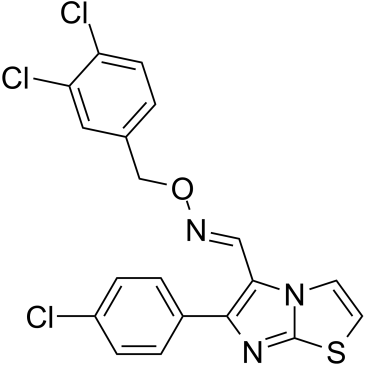CITCO

CITCO structure
|
Common Name | CITCO | ||
|---|---|---|---|---|
| CAS Number | 338404-52-7 | Molecular Weight | 436.74200 | |
| Density | 1.48g/cm3 | Boiling Point | N/A | |
| Molecular Formula | C19H12Cl3N3OS | Melting Point | N/A | |
| MSDS | Chinese USA | Flash Point | N/A | |
| Symbol |

GHS07 |
Signal Word | Warning | |
|
Evaluation of the HC-04 cell line as an in vitro model for mechanistic assessment of changes in hepatic cytochrome P450 3A during adenovirus infection.
Drug Metab. Dispos. 42(7) , 1191-201, (2014) HC-04 cells were evaluated as an in vitro model for mechanistic study of changes in the function of hepatic CYP3A during virus infection. Similar to in vivo observations, infection with a first generation recombinant adenovirus significantly inhibited CYP3A4 ... |
|
|
Involvement of CAR and PXR in the transcriptional regulation of CYP2B6 gene expression by ingredients from herbal medicines.
Xenobiotica 45 , 773-81, (2015) 1. Induction of hepatic drug-metabolizing enzymes can affect drug efficacy and cause toxicity. However, so far, limited information is available regarding the molecular mechanism how herbal medicines induce human CYP2B6, which metabolizes many of the clinical... |
|
|
Quantitative high-throughput identification of drugs as modulators of human constitutive androstane receptor.
Sci. Rep. 5 , 10405, (2015) The constitutive androstane receptor (CAR, NR1I3) plays a key role in governing the transcription of numerous hepatic genes that involve xenobiotic metabolism/clearance, energy homeostasis, and cell proliferation. Thus, identification of novel human CAR (hCAR... |
|
|
Chrysin, baicalein and galangin are indirect activators of the human constitutive androstane receptor (CAR).
Toxicol. Lett. 233(2) , 68-77, (2015) The constitutive androstane receptor (CAR) is a crucial transcriptional regulator of key xenobiotic-metabolizing enzymes such as cytochrome P450 CYP3A4, CYP2C9 and CYP2B6. The flavonoids chrysin, baicalein and galangin have been reported to activate CAR and i... |
|
|
Dose-dependent induction of signaling pathways by the flavonoid quercetin in human primary hepatocytes: A transcriptomic study.
Mol. Nutr. Food. Res. 59 , 1117-29, (2015) Quercetin is widespread in plant kingdom and consumed regularly with human diet (16 mg/day). Due to reported positive effects on health, quercetin supplements with recommended doses up to 2 g/day are offered. However, molecular effects of such high doses on h... |
|
|
Activating and Inhibitory Functions of WNT/β-Catenin in the Induction of Cytochromes P450 by Nuclear Receptors in HepaRG Cells.
Mol. Pharmacol. 87 , 1013-20, (2015) The WNT/β-catenin signaling pathway has been identified as an important endogenous regulator of hepatic cytochrome P450 (P450) expression in mouse liver. In particular, it is involved in the regulation of P450 expression in response to exposure to xenobiotic ... |
|
|
Human receptor activation by aroclor 1260, a polychlorinated biphenyl mixture.
Toxicol. Sci. 140(2) , 283-97, (2014) Polychlorinated biphenyls (PCBs) are persistent environmental toxicants, present in 100% of U.S. adults and dose-dependently associated with obesity and non-alcoholic fatty liver disease (NAFLD). PCBs are predicted to interact with receptors previously implic... |
|
|
CINPA1 is an inhibitor of constitutive androstane receptor that does not activate pregnane X receptor.
Mol. Pharmacol. 87(5) , 878-89, (2015) Constitutive androstane receptor (CAR) and pregnane X receptor (PXR) are xenobiotic sensors that enhance the detoxification and elimination of xenobiotics and endobiotics by modulating the expression of genes encoding drug-metabolizing enzymes and transporter... |
|
|
Retinoids induce cytochrome P450 3A4 through RXR/VDR-mediated pathway.
Biochem. Pharmacol. 75(11) , 2204-13, (2008) A panel of retinoids and carotenoids was screened as potential inducers of CYP3A4 through the RXR/VDR-mediated signaling pathway. Transient transfection assays revealed that 3 out of 12 retinoids screened transactivated RXRalpha/VDR and induced CYP3A4 reporte... |
|
|
The inhibition of constitutive androstane receptor-mediated pathway enhances the effects of anticancer agents in ovarian cancer cells.
Biochem. Pharmacol. 90(4) , 356-66, (2014) Ovarian cancer is commonly treated with anticancer agents; however, many tumors become resistant. Resistance is regulated, in part, by P-glycoprotein, which is encoded by the gene multiple drug resistance 1 (MDR1) and functions as a transmembrane efflux pump ... |